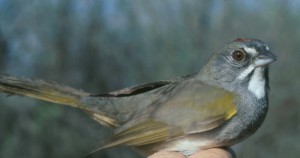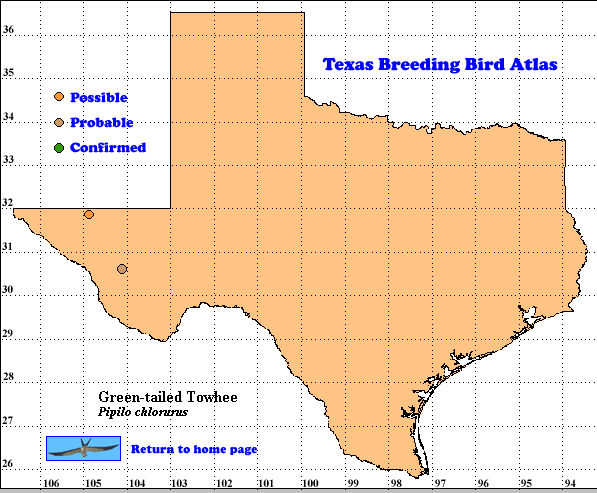Green-tailed Towhee is another species restricted in Texas to the Trans-Pecos mountains in breeding season, although it is present across much of this state in winter. As with many other species of western North American birds, much more needs to be learned about its life history. Its shy habits during the breeding season make study difficult.
Recent studies of mitochondrial DNA indicate this species is much more closely related to Spotted (P. maculatus) and Eastern (P. erythrophthalmus) towhees than to the “brown towhees” (Abert’s, California and Canyon; Greenlaw 1996, Dobbs et al. 1998).
DISTRIBUTION. Historically Green-tailed Towhee bred in the mountains of Trans-Pecos Texas. This population has been decreasing over the past century and the 6 possible records from the Guadalupe Mountains (latilong 31104) and one probable and 2 possible records from the Davis Mountains (30104) from TBBA project field work in 1987-1992 suggest the situation has not changed.
In winter the Trans-Pecos region is the most reliable area in the state for finding Green-tailed Towhees. In the rest of the state this towhee is generally most common in the brushy areas of western and southern Texas (Oberholser 1974).
Across the western United States, Green-tailed Towhees breed at medium to high elevations from Oregon, southern Idaho and Montana, south to the California- Mexico border, the southern Sierra Nevada Mountains, central Arizona and northern New Mexico. Isolated resident populations breed in northern Baja California (Mexico) and southeastern New Mexico. The species winters along the Pacific Coast from San Francisco to the southern tip of Baja California in Mexico, the deserts of southern California, central Arizona and southern New Mexico south on the Mexican mainland to the northern border of the state of Oaxaca (Dobbs et al. 1998)
SEASONAL OCCURRENCE. Any Green-tailed Towhees breeding in Texas nest from June to August. Winter visitors arrive starting as early as September 4 with most arriving by October and leaving in April (latest date May 25) (Oberholser 1974, Lockwood and Freeman 2004).
BREEDING HABITAT. In Texas Green-tailed Towhee breeds in brushy areas at elevations between 1400 and 2100 m (4600 to 7000 ft) and probably higher. The nest is placed on the ground (concealed by vegetation) or in scrub oak thickets, cactus or currant less than 0.7 m (28 in) above the ground. The deep cup, sometimes bulky, is built of plant stems, grasses, leaves, bark strips, twigs and pine needles and lined with rootlets, fine plant stems and hair.The outside diameter is 15 cm (6 in), height 7.5 cm (3 in), inside diameter 6 cm (2.5 in) and cup depth 4 cm (1.5 in; Oberholser 1974, Harrison 1979, Dobbs et al. 1998).
The female lays 4 (range 2-5) white eggs, tinged bluish, greenish or grayish. When the incubating female is flushed from the nest, she scurries away rapidly on the ground or leaves secretly. The female incubates the eggs for 12 (range 11-13) days; the young birds depart the nest 11-14 days after hatching. Green-tailed Towhees are rarely parasitized by Brown-headed Cowbirds (Molothrus ater; Oberholser 1974, Harrison 1979, Dobbs et al. 1998)
STATUS. Lockwood and Freeman (2004) described the Green-tailed Towhee in breeding season as rare to locally uncommon at higher elevations in the Davis and Guadalupe mountains of Trans-Pecos Texas. Since 1900 increasing aridity and grazing by goats seem to have reduced the breeding population of Green-tailed Towhees in Texas. No evidence of nesting in the state was found between 1936 and 1969. The 2 unconfirmed breeding records for this species in the Trans-Pecos mountains are not encouraging for the future of this species as a breeder in Texas (Oberholser 1974).
Between October and April, the species is common in the western half of Texas east through the High Plains south of the Panhandle. (Lockwood and Freeman 2004).
The Breeding Bird Survey does not sample the Green-tailed Towhee in Texas. Elsewhere data from 324 routes reporting the species across its wide range in the western United States produce a 95% confidence interval (-1.3 to 0.6%, 19 times out of 20 the actual value will fall between these 2 numbers) population change per year for 1966-2004 (Sauer et al. 2005).
Although the breeding status of Green-tailed Towhee in Texas is tenuous, this trend data suggest the species will continue to be a winter resident in Texas for many years. text by Robert C. Tweit (2005)
Literature cited:
Dobbs, R. C., P. R. Martin, and T. E. Martin. 1998. Green-tailed Towhee (Pipilo chlorurus). In The Birds of North America, No. 368 (A. Poole and F. Gill, eds.). The Birds of North America, Inc., Philadelphia, PA.
Greenlaw, J. S. 1996. Spotted Towhee (Pipilo maculatus). In The Birds of North America, No. 263 (A. Poole and F. Gill, eds.). The Birds of North America, Inc., Philadelphia, PA.
Harrison, H. H. 1979. A field guide to western birds’ nests. Houghton Mifflin, Boston, MA.
Lockwood, M. W. and B. Freeman. 2004. The TOS handbook of Texas birds. Texas A&M University Press, College Station.
Oberholser, H. C. 1974. The bird life of Texas, Vol. 2. University of Texas Press, Austin.
Sauer, J. R., J. E. Hines, and J. Fallon. 2005. The North American Breeding Bird Survey, results and analysis 1966-2004. Version 2053.1. USGS Patuxent Wildlife Research Center, Laurel MD (Web site, http://www.mbr-pwrc.usgs.gov/bbs).

